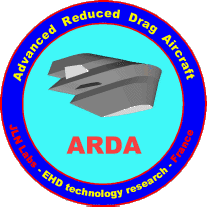

The
Northrop shock wave reduction experiment
"
Electroaerodynamics in supersonic flow "
Advanced Reduced Drag Aircraft
By Jean-Louis Naudin
created on
September 8th, 2001 - JLN Labs
- Last update January 21th, 2003
All
informations in this page are published free and are intended for
private/educational purposes and not for commercial applications
The purpose of this experiment is to demonstrate that it is possible to obtain a significant drag reduction effect and also to eliminate the shock wave on the leading edge of a wing by using the Biefeld-Brown Effect.
In the Townsend
Brown Electrokinetic Apparatus described in the US Patent N°2949550 filed on Aug 16, 1960
and titled "Elektrokinetic Apparatus" we
can read :
<< It is therefore an object of my
invention to provide an apparatus for converting the energy of an
electrical potential directly into a mechanical force suitable
for causing relative motion between a structure and the
surrounding medium. It is another object of this invention to
provide a novel apparatus for converting and electrical potential
directly to usable kinetic energy.
It is another object of this invention to provide a novel
apparatus for converting electrostatic energy directly into
kinetic energy.
It is another object of this invention to provide a vehicle
motivated by electrostatic energy without the use of moving
parts.
It is still another object of this invention to provide a self-
propelled vehicle without moving parts. It is a feature of my
invention to provide an apparatus for producing relative motion
between a structure and the surrounding medium which apparatus
includes a pair of electrodes of appropriate form held in fixed
spaced relation to each other and immersed in a dielectric medium
and oppositely charged. It is another feature of my invention to
provide apparatus which includes a body defining one electrode,
another separate electrode supported in fixed spaced relation by
said body, and a source of high electrical potential connected
between the body and the separate electrode. >> (
Extract from US Patent N°2949550 filed on Aug 16, 1960 titled
"Elektrokinetic Apparatus" )
The Biefeld-Brown Effect is fully used in the ARDA Project and I have already fully demonstrated in Dec 5th, 1999 that this effect is able to generate a thrust on a suspended wing without moving part. ( see the ARDA mk3 "Power On Board tests " )
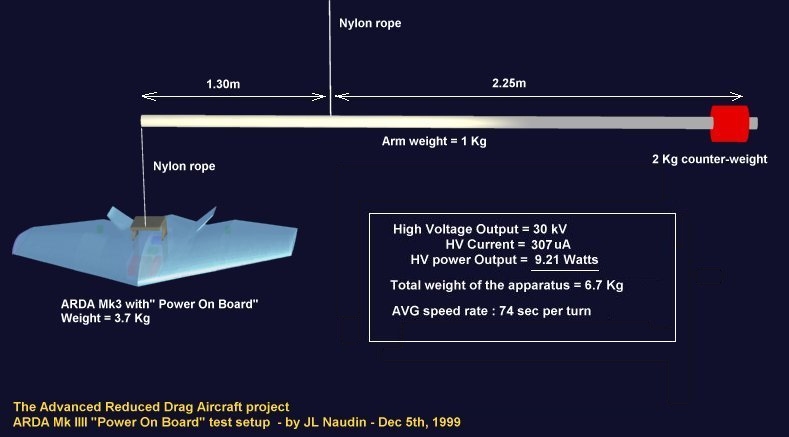
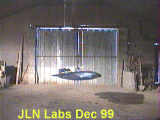
So, the logic continuation of the ARDA Project is to check experimentaly if it is possible to display, with a simple apparatus, the drag reduction effect and the shock wave elimination on the leading edge of the wing by using the Biefeld Brown effect.
In 1968 and in 1970 M.S. Cahn and G.M. Andrew from Northrop Corporation have published two very interesting papers :
AIAA 6th Aerospace Sciences Meeting " Electroaerodynamics in supersonic flow" by M.S.Cahn and G.M.Andrew from Northrop Coporation - N°68-24 January 22-24, 1968.
AIAA 3rd Fluid and Plasma Dynamics conference" Recent experiments in supersonic regime with electrostatic charges" by M.S.Cahn and G.M.Andrew from Northrop Coporation - N°70-759 June 29-July, 1970.
We can read in these papers : << The tests definitely show that it is possible to modify the airflow and shock structure of a body by electrodynamics.... The tests have proven that electronic charges have considerable effect on supersonic flow. At Mach number 1.4, large changes in shock wave structure were caused using moderate power..... When about 10 to 15 kilovolts were applied to the rod in DC100 there was a large effect on the shock pattern.... Visual observations from the liquid surface indicated that the overall shock pattern was significantly flattened out.>>
Today, I have replicated successfully the Cahn and Andrew experiment, done in 1970, to check myself that the effect observed is real.
The Northrop Shock Wave Reduction experiment - Testing apparatus on September 8th, 2001
The experiment choosen is the " Liquid Surface test ". I have used a common 30 cm diameter pie dish filled with sunflower oil ( Kinematic Viscosity : sunflower oil = 66 cSt, air = 0.145 cSt, cSt: centistokes ) and placed on a 33 RPM record player. A small Biefeld Brown wing is submerged in the oil.
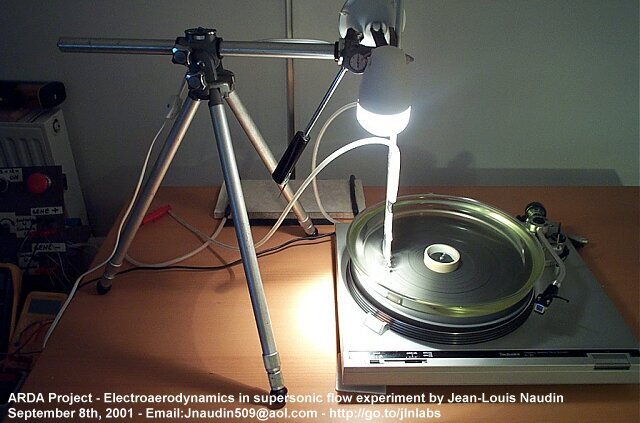
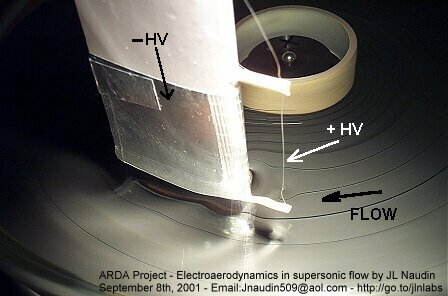
The wing is covered with an aluminum foil and connected to the negative pole of the HV generator. A thin copper wire placed at 12mm from the leading edge of the wing is connected to the positive pole of the HV generator. This is the basic setup of the Biefeld-Brown wing.
Tests results on 09-08-01 :
When the oil flow is set in continuous rotation ( linear speed = 38 cm/sec ) WITHOUT HIGH VOLTAGE APPLIED, a shock wave pattern can be easily seen in front of the leading edge. ( see the photos below )
When HIGH VOLTAGE IS APPLIED, the shock wave pattern at the leading edge is significantly reduced ( at low voltage ) or better completly removed at about 8 kilovolts ( see below ). It is interesing to notice that the oil flow also accelerates along the wing surface.
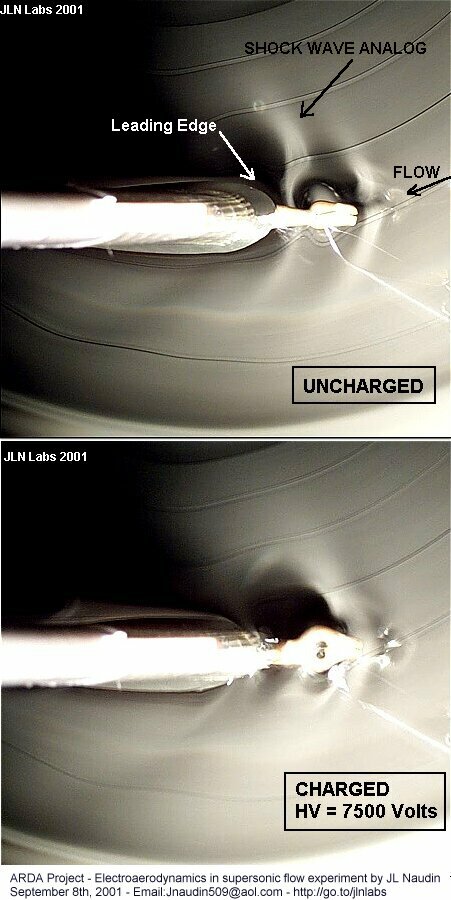
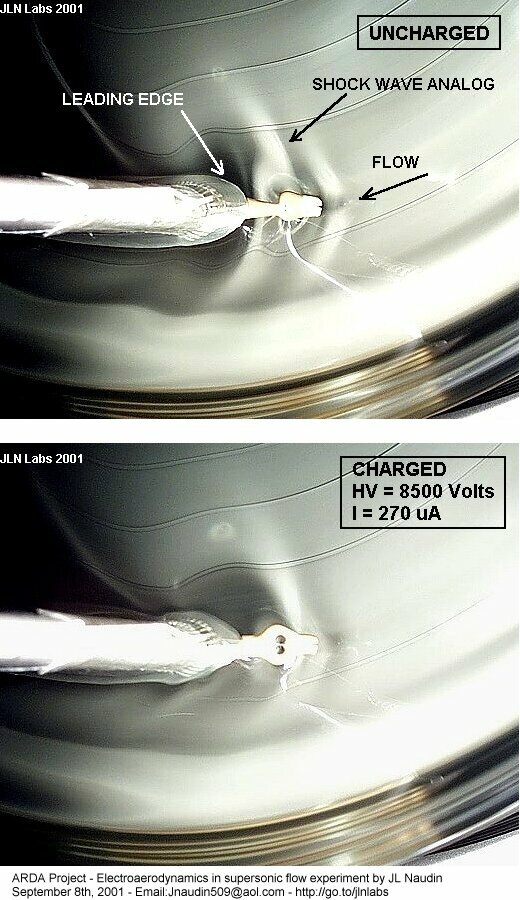
Conclusion ( JLN 09-09-01 ) : These series of tests are very encouraging and now I can fully confirm the M.S. Cahn and G.M. Andrew observations done in 1970 about the possibilty of shock wave elimination and drag reduction with a Biefeld-Brown type wing. With a current lab setup, I am now able to fully explore and test some new enhanced EHD wings for the new ARDA mk9 EHD/UAV currently under construction....
Documents references :
AIAA 6th Aerospace Sciences Meeting " Electroaerodynamics in supersonic flow" by M.S.Cahn and G.M.Andrew from Northrop Coporation - N°68-24 January 22-24, 1968.
AIAA 3rd Fluid and Plasma Dynamics conference" Recent experiments in supersonic regime with electrostatic charges" by M.S.Cahn and G.M.Andrew from Northrop Coporation - N°70-759 June 29-July, 1970.
AIAA 98-0991 "Pressure Investigation of the Hypersonic "Directed-Energy Air Spike" Inlet at Mach Number 10 With Arc Power Up to 70 kW", Toro, P.G.P, Myrabo, L.N., Nagamatsu, H.T., January, 1998.
US Patent N°2949550 filed on Aug 16, 1960 "Elektrokinetic Apparatus" from Thomas Townsend Brown
The AIAA ( American Institute of Aeronautics and Astronautics ) web site
The RPI Aero Lab ( Rensselaer Polytechnic Institute ) LightCraft project
Aérotechniques " Initiation aux sciences de l'aéronautique " ( in French )
L'air ambiant utilisé comme générateur MHD par le B2 by Jean-Pierre Petit
Propulsion aérienne : Vers des aéroports silencieux ( in French )
US Patent N°3446464: Method and apparatus for reducing sonic waves and aerodynamic drag from William A.Donald, May 27, 1969
| US6247671: Ion doping
apparatus and method for aerodynamic flow control http://l2.espacenet.com/dips/viewer?PN=US6247671&CY=ch&LG=fr&DB=EPD
Abstract : Method and apparatus for impingement on the sonic wave produced by a supersonic gas flow and the gas flow in a boundary layer of a gas that interfaces with a solid substrate comprising providing a source of a mixture of ions and electrons, introducing said ions and electrons into the region behind the sonic wave and ahead of the boundary layer, separating said ions and said electrons in said region maintaining a substantial portion of said ions proximate said region and maintaining a substantial portion of said electrons remote from said region. |
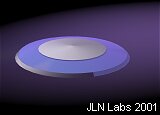 The Enhanced T.T.
Brown Electrokinetic experiment
The Enhanced T.T.
Brown Electrokinetic experiment
![]() Email : JNaudin509@aol.com
Email : JNaudin509@aol.com
Return to the Advanced Propulsions Researches page